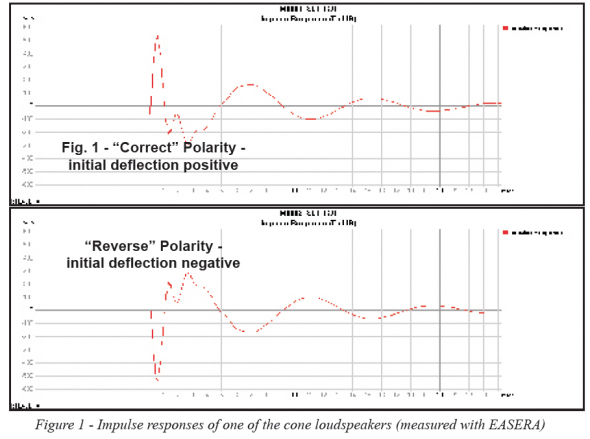Here’s a simple way to construct an irrefutable polarity test rig to check out your measurement system:
1) Get two small cone transducers to use as a reference – the simpler the better.
2) Momentarily connect a 9V battery (+ to + and – to -) to each loudspeaker.
3) The loudspeaker cones should move away from the magnet.
4) Check all of your measurement audio interconnect cables for proper polarity with a cable tester. I use simple twisted pair no shield and visual inspection.
Since both devices have been visually verified to have the same polarity, you can use one as a mic and the other as a loudspeaker to test your measurement rig.
Just wire an XL male to one and connect it to the mic input of your outboard audio device.
Since the cones are facing each other, the + and – on the “microphone” loudspeaker should be swapped. This will make an inward deflection of the “cone mic” produce a positive-going voltage on pin 2 relative to pin 3 of the XL male connector.
Connect the other one to the line output of your audio device, again with + to + and – to -. Face the cones toward each other. The audio level will be very low, so place them as close as possible. The polarity of these simple transducers is easy to determine (Figure 1).

For Sound Cards
Gather an impulse response and make sure that the initial deflection is positive. If it is, then your measurement sound card is properly polarized.
For Microphones
Substitute your measurement mic for the “cone mic” and repeat the IR collection, again checking for a positive initial deflection.
For Polarity Test Sets
Check the polarity of the test loudspeaker with your polarity tester. It should indicate correct polarity.
You can now trust your polarity tester to indicate the correct absolute polarity.
While this may seem like a lot of trouble, it only needs to be done once for a given measurement rig. The major advantage of this technique is that a “golden reference” device is not required for either the mic or loudspeaker.
Since these simple transducers can be visually tested with a battery, you can be certain as to their polarity without relying on specifications or markings.















